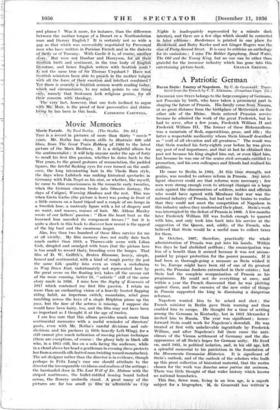Movie Memories
Movie Parade. By -Paul Botha. Studio. 10s. &L) Tins is a record-in _pictures of more than thirty." movie" years. Mr. Rotha has chosen stills to illustrate 600 odd films, from The Greed Train Robbery of .1903 to the latest picture of the Marx Brothers. It is a delightful album for the sentimentalist : it will help anyone under the age of forty to recall his first film passion, whether he dates back to the War years, to the grand gestures of renunciation, the padded figures, the fateful flashing eyes for ever turned on the audi- ence; the long intoxicating hair in the Theda Bars style, the days when Lubitsch was making historical spectacles in Germany with Pola Negri as his star, or whether, like myself, he came to film consciousness in the romantic early twenties, when the German cinema broke into Otranto fantasy, the days of Caligari, Warning Shadows and the rest. This was when Greta Garbo (the picture is here) was posing in front of a little camera on a hand tripod and a couple of are lamps in a Swedish lane, a matronly figure with a lot of drapery and no waist, and masses, masses of hair. Mr. Aldous Huxley wrote of our fathers' passion : "How the heart beat as the loosened bun uncoiled its component tresses ! " but it is quite a shock in this book to discover how recent is the appeal of the big bust and the enormous toupet.
Alas, less than two hundred of these films survive for me at all vividly. My film memory does not really date back much earlier than 1919, a Thames-side scene with Lilian Gish, dimpled and smudged with tears (but the picture here is too small to record that), brooding over the barges. That film of D. W. Griffith's, Broken Blossoms, heavy, simple, honest and sentimental, with a kind of rough poetry (he put the same folk- quality into even so crude a melodrama as Way Dowel East, unfortunately not represented here by the great scene on the floating ice), takes all the savour out of the more cunning, better lit, " artistic " still of the same story made in 1980. I miss here the Sophy of Kravonia of 1917 which contained my first film passion. I retain no more than an enchanting vision of a heavily booted flapping riding habit, an imperious switch, mountains, rebel guns rumbling across the keys of a single Brighton piano up the pass, but the face of the actress is missing. I suppose she would have been hairy, too, and the film may not have been so important as I thought it at the age of twelve.
I am less sure that this album provides much more than sentimental memories with a useful reminder of directors' pasts, even with Mr. Rotha's careful divisions and sub- div&ions and his prefaces (a little heavily Left-Wing), for a still cannot give much indication of moving picture technique (there are exceptions, of course : the glossy lady in black silk who, in a 1915 still, lies on a sofa facing the audience, while in a cloud above her head a gentleman in evening dress protects her from a smooth silk-hatted man twisting waxed moustaches). The art designer rather than the director is in evidence, though perhaps in Fritz Lang's case one should attribute to the director the incomparable vividness and realism of the settings : the barricaded door in The Last Will of Dr. Mabuse with the striped mattresses, the bullet-riddled ironing board bolted across, the flowery umbrella stand. A great many of the pictures arc far too small (a--filln-lra" -fidMinible- as City Nights is inadequately represented by a minute dark iaterior), and there are a few slips which should be corrected in later- editions Bordertown is printed in one place for Borcierlarid, and Ruby Keeler and not Ginger Rogers was the star of Forty-Second Street. It is easy to criticise an anthology for its omissions : I miss The Robber Symphony, DoOd Wafer, The Old and the Young 'King, but no one can be other than grateful for the immense industry which has gone into this
















































 Previous page
Previous page